This post may contain affiliate links. Please read our disclosure policy.
A basic recipe for gluten free pizza dough is one of the single most important staples to have in your kitchen. It's super simple to make, freezes well, and defrosts easily.
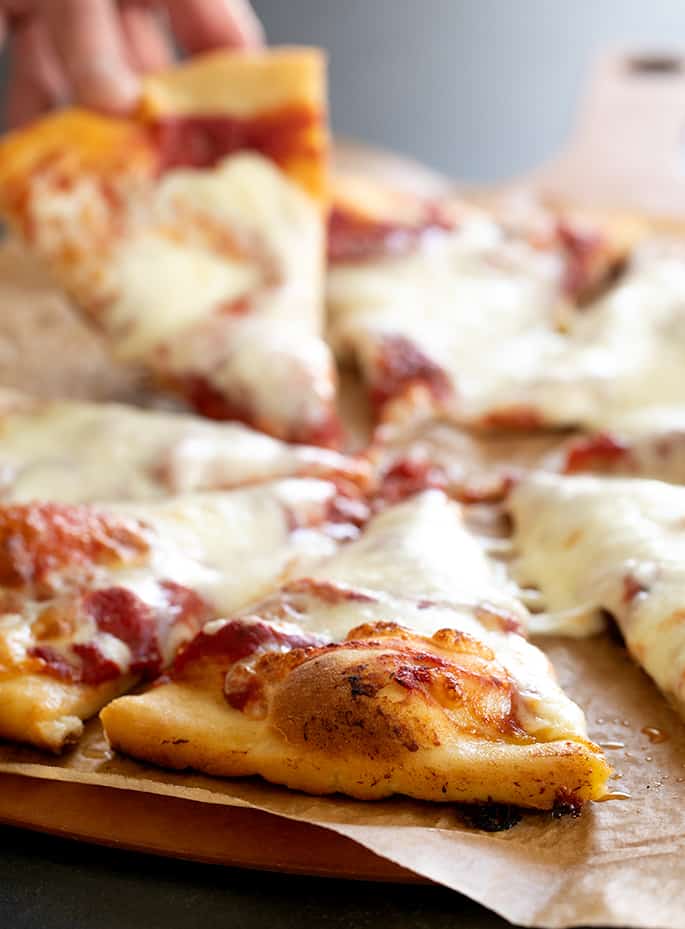
Table of Contents
- Gluten free pizza night = a night off!
- Why is this the best basic gluten free pizza?
- What gf flours are in gluten free pizza crust?
- Tips for making the best simple gluten free pizza crust recipe
- Can I make this gluten free pizza dough ahead of time?
- Ingredients and substitution suggestions for this recipe
- Gluten free pizza recipes
- FAQs
- How to make the best gluten free pizza dough, step by step
- Basic Gluten Free Pizza Dough Recipe
Gluten free pizza night = a night off!
It's so easy to make this basic gluten free pizza crust that the day you make it for dinner, it'll feel like a night off. I promise. I first started Friday night pizza nights in my house when my oldest child started full-day kindergarten.
All my daughter could talk about was that they served pizza in the school cafeteria every single Friday. The kids lined up forever to buy it—and you know it most likely wasn't very good. But they got it every Friday!
By the end of the week, I'm usually worn out from a week of work and the last thing I want to do fuss with a multi-step meal. Gluten free pizza is about all I can manage!
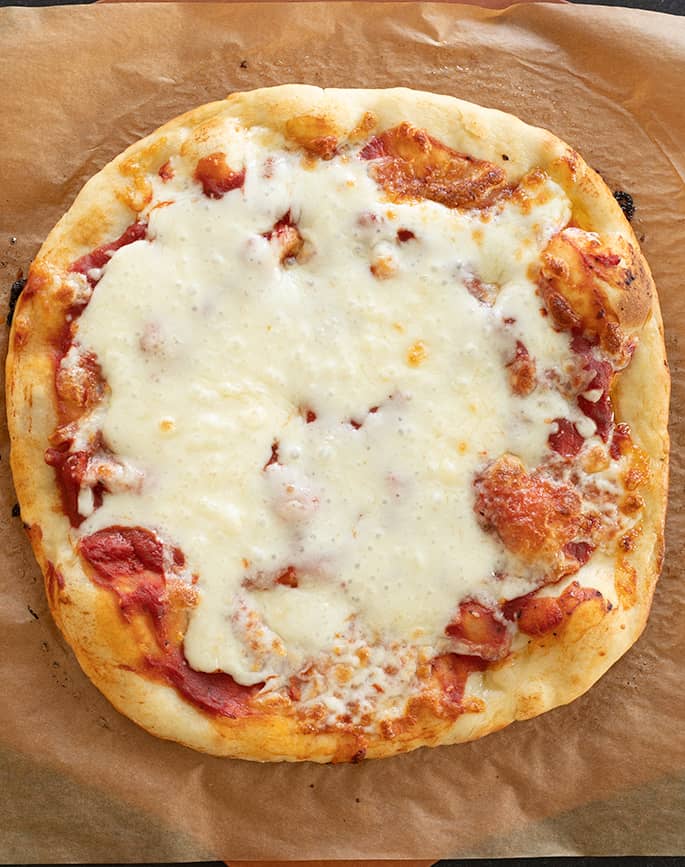
Why is this the best basic gluten free pizza?
For so many years, this was my tried and true pizza crust recipe—until I wrote Gluten Free on a Shoestring Bakes Bread. When I wrote that book, I thought I had turned the page from recipes like this basic crust forever.
This recipe, and others like my gluten free sandwich bread and Japanese milk bread use only an all purpose gluten free flour blend instead of the “bread flour” blend with whey protein isolate in it from the book.
If you're curious about the newer pizza recipes, the Thick Crust Gluten Free Pizza from the book is reprinted right here on the blog. You can find out how to make our gluten free bread flour on the flour blends page. If you'd like to use an entirely different flour instead, you'd need a separate recipe entirely, like or Caputo Fioreglut pizza recipe.
But this recipe has slowly worked its way back into our regular Friday night rotation, and I'm finding that in some ways my family and I actually prefer it to the newer recipes. Let me explain…
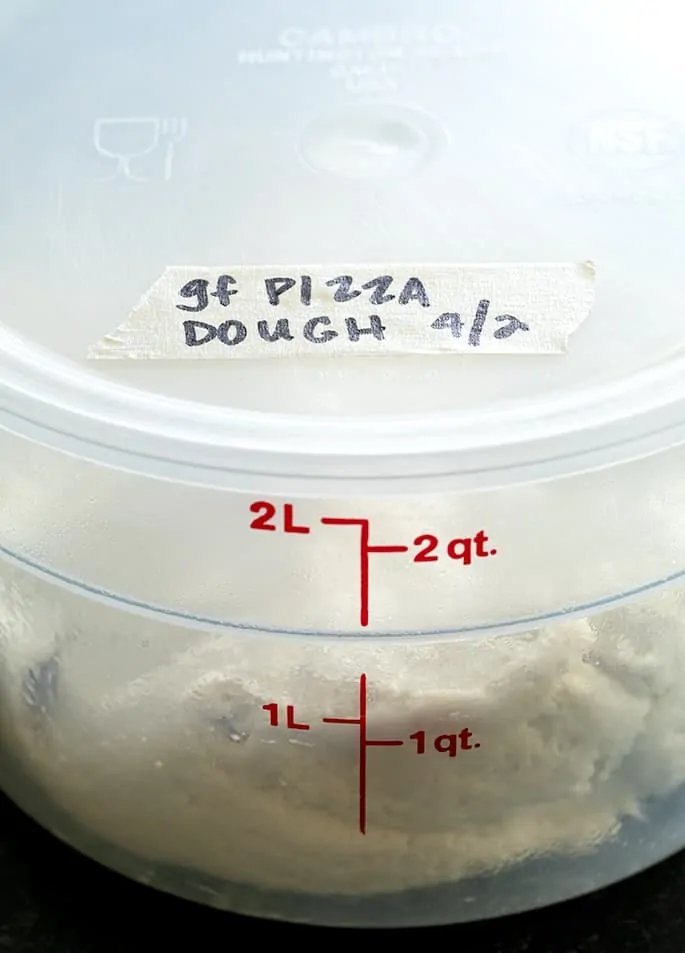
What gf flours are in gluten free pizza crust?
In the recipe as written, there really are very few gluten free pizza crust ingredients—and you don't need our gluten free bread flour blend, which is made with some specialized ingredients. But it's worth a quick discussion of that flour, to help you understand the difference between this recipe and our other gluten free pizza dough recipe.
What's in gluten free bread flour?
The gluten free bread flour blend from Gluten Free on a Shoestring Bakes Bread is a combination of an all purpose gluten free flour blend like Better Batter, whey protein isolate plus Expandex modified tapioca starch (affiliate link).
Whey protein isolate is simply a milk protein powder that is nearly 100% protein and is often used for bodybuilding and low carb recipes these days. I've found that it behaves a lot like gluten in baking.
However, whey protein isolate tends to make raw dough very soft. Together with Expandex modified tapioca starch, it allows for the creation of gluten free bread recipes that look, feel and taste more like conventional yeast bread.
The gluten free bread flour and the recipes in GFOAS Bakes Bread is so important to me and valuable to readers. But I understand that its reach is limited.
If you can purchase whey protein isolate and Expandex, and tolerate dairy you can and should use the gluten free bread flour. There is no perfect nondairy substitute for whey protein isolate.
Whey protein isolate in gluten free bread flour
The whey protein is essential to the gluten free bread flour since milk protein (casein) is the protein that behaves most like wheat gluten in baking applications. Chemically, they're very similar.
But that means that I can't provide viable suggestions for a dairy-free version of those recipes. Baking with whey protein does cause the dough to relax quite a bit.
Expandex modified tapioca starch is amazing when you're trying to create the “chew” of conventional, gluten-containing bread. The combination of whey protein isolate and Expandex, plus our all purpose gluten free flour, creates gluten free bread flour.
In the bread book, I recommend a few dairy-free substitutes for whey protein isolate (pea protein isolate and rice protein isolate). None of them is a perfect substitute. Plus, each requires that you use 150% of the liquid the original recipe calls for, which nearly defeats the purpose of using protein powder.
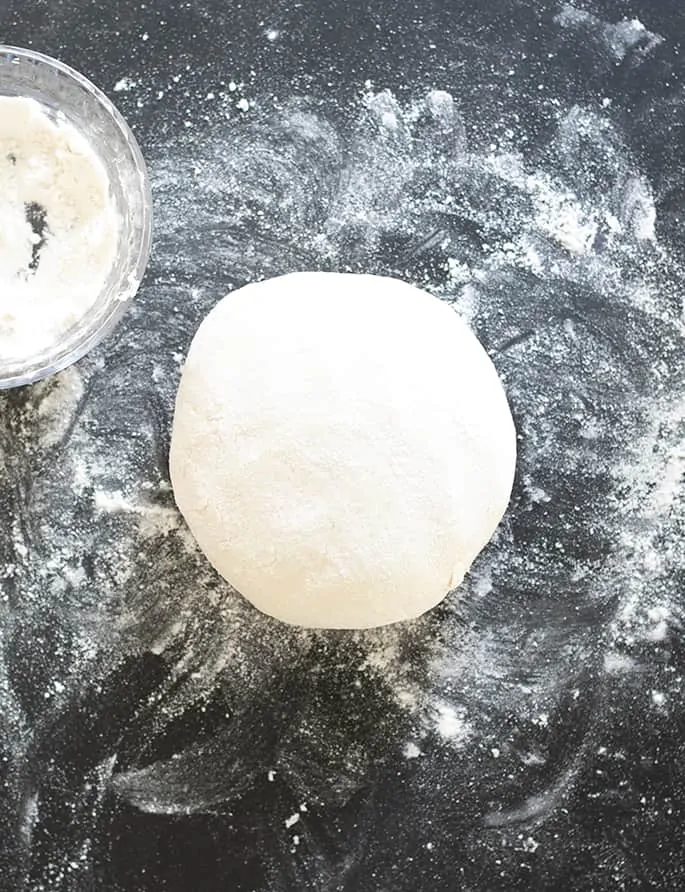
Modified tapioca starch in gluten free bread flour
Expandex, a chemically (not genetically) modified tapioca starch, has only one substitute: Ultratex 3. It's another version of a similar modified tapioca starch that appears to be 3 times as strong as Expandex.
In this basic gluten free pizza recipe, I've discovered that I really like replacing some of the flour blend with a bit of Expandex. Expandex makes the dough easier to handle when raw and chewier when baked.
Expandex it even helps you get those blisters in the parbaked crust that you see in these photos. Plus, the leftover slices actually taste great right out of the refrigerator, like leftover pizza properly should!
If you'd like to use Ultratex 3 in place of Expandex, try using 12 grams of Ultratex 3 (instead of 36 grams of Expandex). Then, increase the all purpose gluten free flour by 24 grams to make up the difference.
Since Ultratex seems to be more available outside the U.S. than Expandex, I've located a few online resources for Ultratex 3 in various countries. For details, please see our GF Resources page.
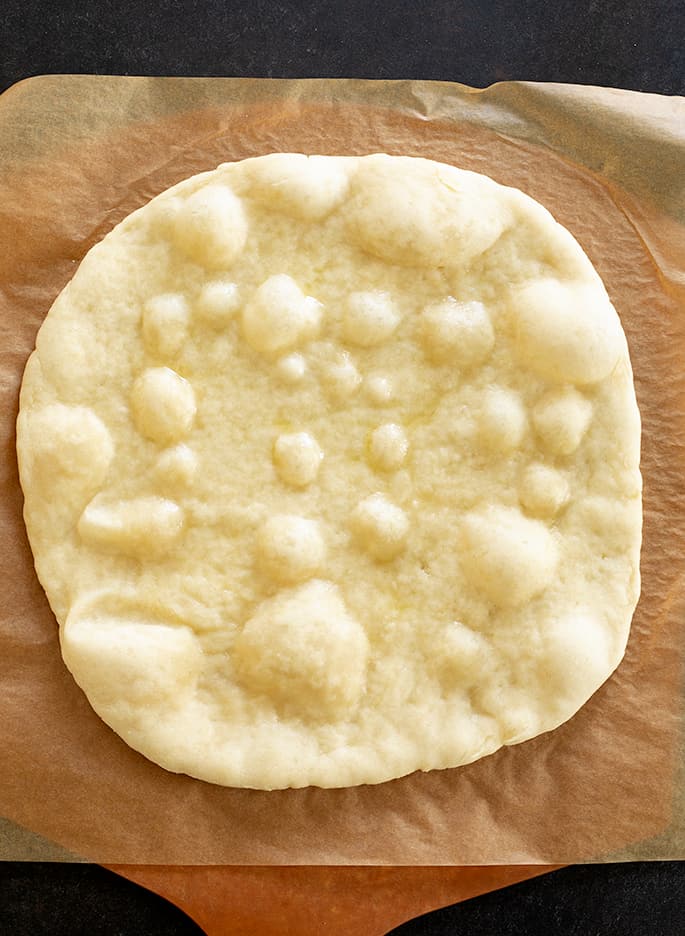
Tips for making the best simple gluten free pizza crust recipe
Measuring gluten free flour
Always measure individual gluten free flours and blends by weight, not by volume. There's unavoidable human error in measuring by volume, and dry measuring cups simply aren't standardized. Measuring by weight on a simple, $15 digital scale (Escali is a good, inexpensive brand) means that we're all on the same page.
Let your gf pizza dough rest
After you've made your raw gluten free pizza dough, let it rest in the refrigerator. That allows the flours to absorb the moisture of the water, leaving the dough still hydrated, but making it much less sticky.
Working with sticky gluten free pizza dough
If your gf pizza dough is still a bit sticky because you can't afford the time to let it rest more, or it's not cold enough, sprinkle it very lightly with more all purpose gluten free flour, and handle it with a light touch. You can also lightly oil your hands.
Can I make this gluten free pizza dough ahead of time?
Yes! One of my favorite things about pizza night is the ease of it. I never recommend freezing raw yeast dough, since it can kill the yeast if the temperature drops too low.
But there are two ways to make this dough ahead of time—and make your life so easy:
Make the raw gluten free pizza dough up to 3 days ahead of time
The whole recipe for the pizza dough can be made up to 3 days ahead of time and stored in a tightly-sealed container in the refrigerator. It's best to work with the dough cold, so you'll shape it right out of the refrigerator.
Be careful not to allow the dough to dry out in the refrigerator, as it will do if your container is not well-sealed. I always use 2 liter plastic Cambro buckets for storing dough, since the seal is perfect. If your dough dries out, it won't rise.
Freeze the parbaked gluten free pizza crust
If you'd prefer to have a half-baked crust on hand, dinner can be as easy as a premade, packaged frozen pizza crust. Just follow the recipe instructions through step 3 below. Since this recipe makes 2 gluten free pizza crusts, it's easy to make one for tonight, and one for another day.
After the crust has been parbaked for about 7 minutes in a 400°F oven, allow it to cool completely. Once the crust has cooled completely, wrap it very tightly. I like Glad Press n Seal freezer for this sort of thing.
Place the parbaked gluten free pizza crusts in the freezer for up to a month. Even better than Press n Seal is a food sealer that removes all trapped air from the container, since trapped air is what causes freezer burn.
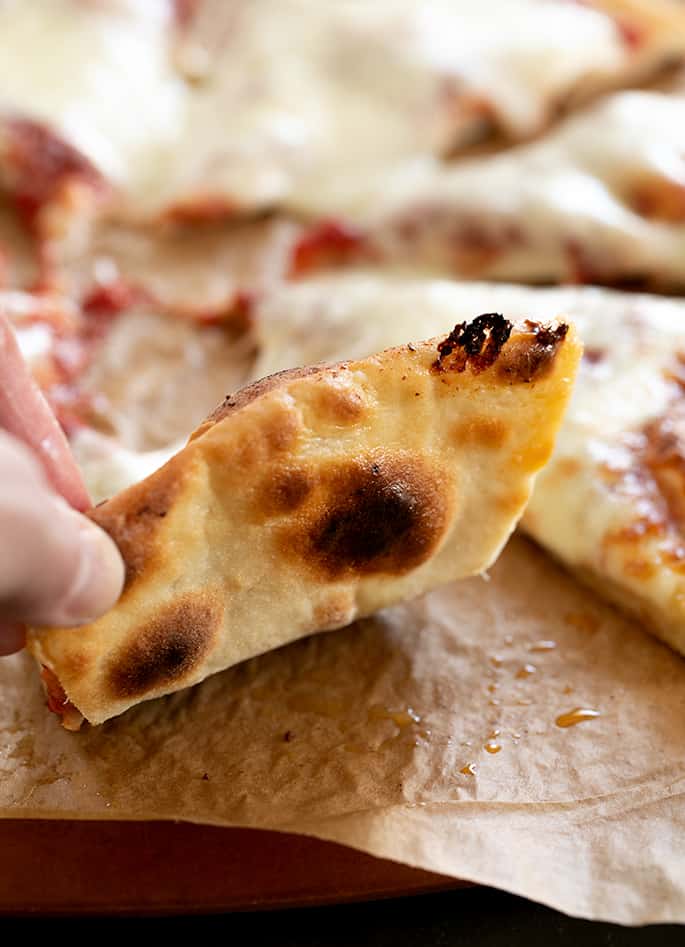
Ingredients and substitution suggestions for this recipe
This recipe is naturally egg-free, which isn't something you can often say about most gluten free bread recipes, which tend to rely upon eggs for structure.
How to make gluten free dairy free pizza dough
The crust recipe itself is already dairy-free, so no worries there. For a dairy-free shredded cheese to use as a topping, I really like Daiya brand.
Using Expandex modified tapioca starch for chewier gluten free pizza dough
For a complete discussion of how Expandex adds value to this recipe, please scroll up a bit. If you don't have or don't want to use Expandex, you can use 2¾ cups all purpose gluten free flour and make up the remaining ¼ cup of flour with regular tapioca starch/flour.
Tapioca starch will help a bit to make the recipe chewier, although not as much as if you used Expandex. There is no need to add more water to your dough if you aren't using modified tapioca starch.
If you'd like to see some ways you can use gf pizza dough, check out my gluten free pizza dough web story.
Gluten free pizza recipes
The gluten free crust of this pizza can be used for so many different appetizers and other gf recipes. Here are a few of my favorite ways to use gf pizza crust that aren't just, well, a round pizza pie:
- Gluten free pizza pinwheels (made easily in a muffin tin)
- Gluten free calzones (uses a slightly different crust recipe for a slightly different purpose)
- Gluten free pizza rolls, with tomato sauce for dipping!
FAQs
Yes! Place an overturned rimmed baking sheet in the oven to allow as much air circulation as possible. Or try a perforated pizza crisper.
Yes! You can freeze the parbaked (half-baked) gluten free pizza crust recipe by completing the shaping and first bake of the crust for 5 to 7 minutes at 400°F. I don't ever recommend freezing raw gluten free yeast dough, as the yeast can die at extreme temperatures.
If you have a large enough toaster oven that has a round cutout in the back allowing you to bake rounds, you can try cranking up the heat and baking this gluten free pizza crust recipe in a toaster oven.
A good-quality extra virgin olive oil really helps give this pizza dough really nice flavor. You can replace it with a neutral oil, like grapeseed, but you'll miss the richness of the olive oil.
No, almond flour can never be used as an all purpose gluten free flour blend, so you can't use it to make this particular gf pizza dough recipe, which has been developed to be made with a rice-based all purpose blend. But we have an amazing Paleo pizza recipe that is made with blanched almond flour and tapioca starch/flour. Use that!
Yes! Make the most amazing gluten free breadsticks with this very gf pizza crust recipe.
If you've added too much gluten free flour blend by not measuring by weight, used a different flour blend that isn't good quality, or (believe it or not) overmeasured the oil you pizza crust can appear crumbly.
If it's dry and crumbly, try adding more water by the teaspoon until it's smooth. If it's dry and oily, try sprinkling it with just as much extra all purpose gf flour as necessary.
If your gf pizza crust is soggy, ask yourself if you baked it first, before adding toppings, if your oven was hot enough, and if you created enough space around the crust when it was baking to allow the hot air of the oven to circulate. You may just not have baked it long enough!
Try replacing 1/4 cup (35 grams by weight) of the all purpose gluten free flour blend in this recipe (I highly recommend you use Better Batter's classic blend for that) with 35 grams tapioca starch/flour. I find that this minor substitute also makes the raw dough easier to handle.
Yes! This is my favorite gluten free tomato sauce recipe. But Rao's tomato marinara sauce is also great, as is the fresh pizza sauce from Trader Joe's. :)
How to make the best gluten free pizza dough, step by step
Basic Gluten Free Pizza Dough

Equipment
- Stand mixer with paddle attachment or Food processor with steel blade
- Pizza stone (recommended)
Ingredients
- 3 cups (420 g) all purpose gluten free flour blend, (I used Better Batter), plus more for sprinkling (See Recipe Notes)
- 1 ½ teaspoons xanthan gum, omit if your blend already contains it
- 1 tablespoon (9 g) instant yeast
- 1 ½ teaspoons (6 g) granulated sugar
- 1 ½ teaspoons (9 g) kosher salt
- 1 ⅛ cups (9 ounces) warm water, (about 95°F) (See Recipe Notes)
- 4.5 tablespoons (63 g) extra-virgin olive oil, (plus more for brushing)
- Your favorite pizza toppings
Instructions
Make the pizza dough.
- In the bowl of your stand mixer fitted with the paddle attachment or your food processor fitted with the metal blade, place the flour, xanthan gum, (optional Expandex), yeast, and sugar, and whisk to combine with a separate, handheld whisk. Add the salt, and whisk again to combine well.
- Add the water and olive oil, and mix on medium speed in your stand mixer or pulse in your food processor until the dough begins to come together.
- Turn the mixer to high speed or your food processor on and process until the dough is no longer a ball but has begun to appear whipped (about 3 minutes).
- Transfer the dough to an oiled container with a tight-fitting lid or a greased bowl, spray lightly with cooking oil spray, and cover tightly.
- Place in a warm, draft-free area to rise until it’s about 150% of its original volume (about an hour), or refrigerate the dough for up to 3 days.
- When you’re ready to make the pizza, place a pizza stone or overturned rimmed baking sheet in the oven and preheat it to 400°F.
- If you’ve refrigerated the dough, work with it straight from the refrigerator. If you haven’t, place the tightly sealed dough in the refrigerator to chill for at least 15 minutes before working with it, as it’s easiest to work with when it’s chilled.
- To make pizza, place the dough on a lightly floured surface and sprinkle the top lightly with a bit more flour. Knead the dough a bit until it’s smoother, then divide it into two equal portions. Cover the unused portion, so it doesn’t dry out.
- Roll the other half on the floured surface with a rolling pin, moving the dough frequently to prevent sticking. Sprinkle very lightly with additional flour as necessary.
- Create a smooth edge around the perimeter of the dough by pressing the edges with one hand toward the palm of your other.
Bake the pizza.
- Transfer the dough to a large piece of unbleached parchment paper and brush the top of the dough generously with olive oil. Using a pizza peel or other flat surface like a cutting board, transfer the dough to the pizza peel or baking sheet in the preheated oven and bake it plain for 5 to 7 minutes, or until the crust has begun to crisp on the underside.
- Remove the crust from the oven using a pizza peel or large spatula. At this point, the parbaked crust can be cooled completed, wrapped tightly and frozen for at least one month. Simply defrost at room temperature, and then continue with the recipe as written.
- To continue preparing the dough, add your favorite toppings to the parbaked crust, and return the pizza to the hot oven until any cheese is melted and the edges have browned and puffed (another 5 to 7 minutes).
- Remove the pizza from the oven using a pizza peel or large spatula, and allow it to set for 5 minutes before slicing and serving.
Video
Notes
Instead of 3 cups (420 g) all purpose gluten free flour, use 2 3/4 cups (385 g) all purpose gluten free flour and add 1/4 cup (36 g) Expandex modified tapioca starch and increase the water by 1 1/2 ounces to 10 1/2 ounces (1 1/4 cups + 1 tablespoon) water. This recipe was originally published on the blog in 2009 (!). After edits in 2020, all but one of the photos are new; the video and most of the text are new; the recipe was scaled up a bit and the Expandex option was added, but it was otherwise unchanged. Edits in 2022 added more text and resources, but recipe remains unchanged.
Nutritional information. Nutrition information is an estimate, per pizza, without any toppings. It is created using an online nutritional calculator provided as a courtesy, and should not be relied upon.
Nutrition
Nutrition information is automatically calculated, so should only be used as an approximation.

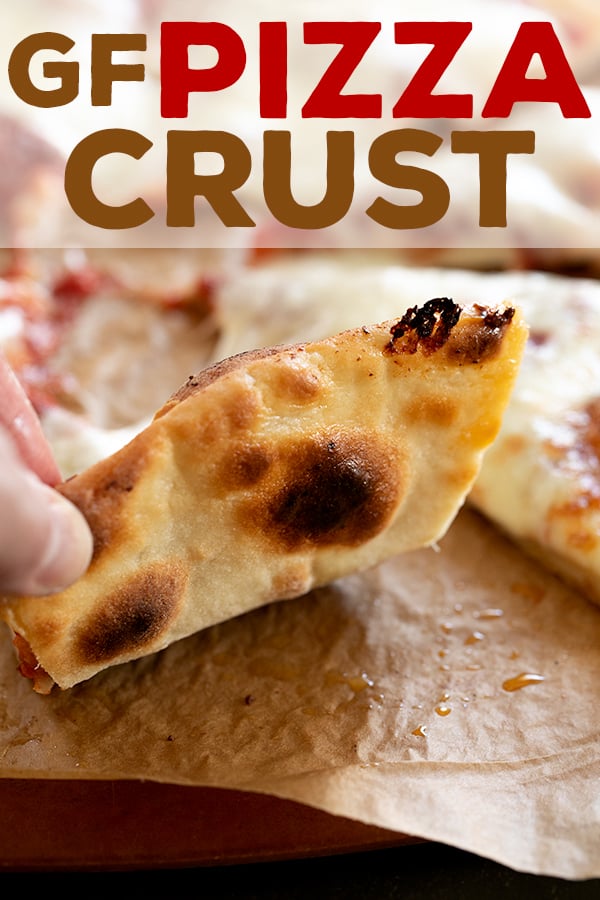
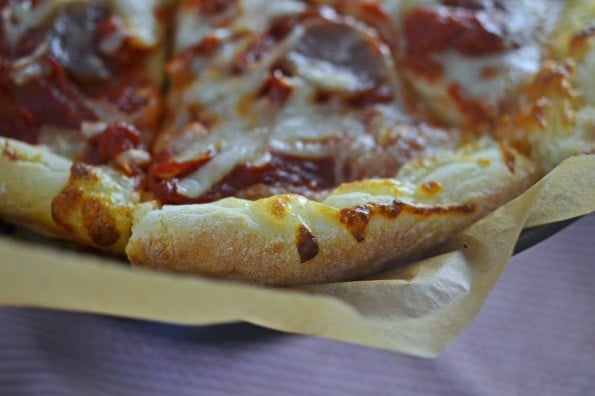
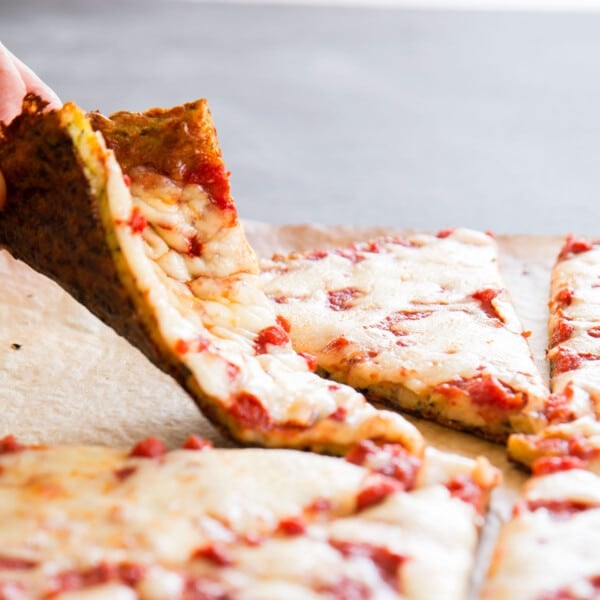
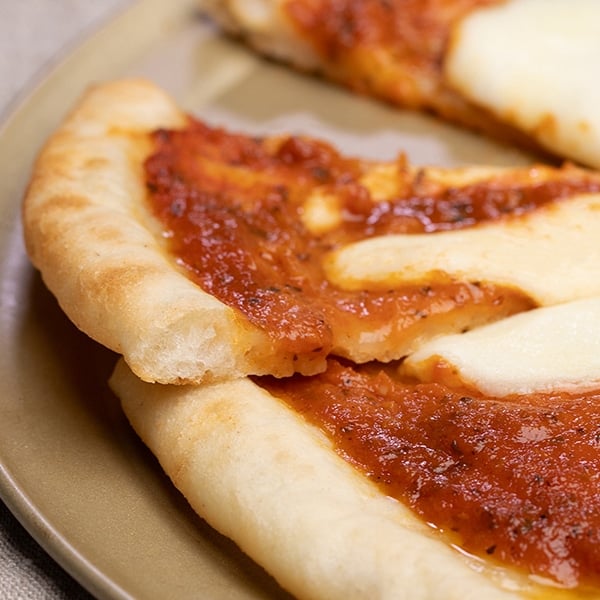











I tried the dough and it turned out pretty good but didn’t quite bubble like the picture, i only have a hand mixer with dough hooks, no food processor or standard mixer, do you know how long i should mix the dough for to make up for my using a hand mixer
You can’t use a hand mixer with this dough, I’m afraid, Linda. Dough hooks will not work on this dough at all, and balloon whisks won’t create a smooth texture. You need a stand mixer to get the smooth dough that will perform as you see in the photos and as described in the text.
EXCELLENT!! This is by far the best pizza I’ve ever made, even better than regular non gluten free!
Hi Nicole! This is my second time attempting this dough and I just can’t ever seem to get the “whipped” texture you describe. The dough turns into a bunch of dough balls and never really fully comes together. It doesn’t seem dry, but I feel like it may need a little extra moisture to get to this stage. I weighed all of the ingredients as you suggested with my kitchen scale, I make a better batter flour blend (according to the recipe in your book). So I’m not sure what I’m doing wrong. My kids love and eat the crust, but it just doesn’t do it for me. It comes out rather hard and crunchy and not beautiful like in your pictures. I want to try again next Friday and I’m hoping that the third times the charm!
Hi, Brittany, are you using a stand mixer, fitted with the paddle attachment? Are you making any substitutions in either the pizza dough recipe, or when making the mock Better Batter flour blend? You may also just be rolling it too thin and/or baking it too long. You also need a very very hot oven, ideally with a pizza stone, so the yeast reacts quickly and creates those beautiful air pockets.
Thank you, Nicole! I have been wanting to make homemade pizza ever since I became GF but did not have a good recipe for the dough. You solved my problem!! Can’t wait to try this now.
Do you mind clarifying on the flour for me. It says you use “Better Batter” but the link next to it discusses “Nicole’s flour”
Which one is best? I’ve only ever used Bob’s 1 to 1, and would love to have a better option for grated breads. I just want to make sure and get the one you test the recipes with.
The link you’re referring to, I assume, is the all purpose gluten free flour blends page here on the blog which contains all the information about flour blends I have. I recommend a careful reading of that page for full clarification. On that same page, I discuss how I recommend explicitly against any Bob’s Red Mill blends and why (they are poorly balanced, of inconsistent quality at best, and use a gritty rice flour). Nicole’s Best is my own blend that I sell, and it is more versatile than and superior to Better Batter, but the company will be taking a break once the current stock is sold, so in the longer term I’d recommend Better Batter.
Can you add calorie counts to your recipes?
I’m afraid I simply don’t have the manpower to do that for all recipes, Deb. Feel free to plug information into an online nutrition calculator like Sparkpeople. That’s all I’d do!
Hi Nicole,
Thanks for responding about the Ultratex 3. Made it without and it was so good! Best pizza we’ve had in years:)
So glad, Sharon! Thanks for reporting back.
I have Ultratex 3 and would like to know the proportion for pizza crust.
Thanks:)
Ultratex 3 is about 3 times as strong as Expandex, Sharon, so I’d recommend using one-third the weight of the Expandex in the recipe, and making up the rest in more all purpose gluten free flour.
This is by far the best gluten free pizza recipe. I use Cup4cup flour and added the Expadex. Celiac for about 25 years and have tried many pizza recipes but this one is a winner.
Thank you, Nicole
I’m so glad you enjoyed it, Lynn. After 25 years, you really deserve a great basic gf pizza recipe!
I can’t wait to try this recipe and let you know how my results turn out. Before I can give this recipe a try, I need to ask if Expandex modified tapioca starch is different than other tapioca starch? If so, I need to specifically get some Expandex on hand. I’ve never seen it in the grocery stores that I frequent.
Hi, Kelcey, yes Expandex is a modified tapioca starch, and I discuss it in detail in this blog post. If you read through the blog post, you’ll find that discussion. It is not the same as conventional tapioca starch.